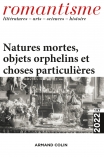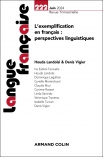
ROMANTISME N°207 (1/2025)
Pour acheter ce numéro, contactez-nous
Recevez les numéros de l'année en cours et accédez à l'intégralité des articles en ligne.
Le texte que Flaubert a présenté à Louise Colet comme la « clôture de [sa] jeunesse », Novembre, fragments de style quelconque, reprend aux Souffrances du jeune Werther de Goethe, le dispositif du manuscrit retrouvé et le schème de la substitution d’un narrateur à un autre, l’entrée en scène du nouveau étant motivée par la mort du premier, et l’extinction de son récit à la première personne. Quel usage Flaubert a-t-il fait de cette technique issue du roman épistolaire et du roman de confession ? Bien que porteur d’accents romantiques et nourri de réminiscences goethéennes, ce roman autobiographique constitue une oeuvre de transition vers la sortie du romantisme, posant à nouveaux frais les enjeux de l’écriture à la troisième personne.
The text that Flaubert presented to Louise Colet as the “end of [his] youth”, Novembre, fragments de style quelconque, takes the literary device of the rediscovered manuscript from Goethe’s Souffrances du jeuneWerther, along with the structure whereby one narrator replaces another, the second appearing after the first one dies and their first-person narrative ends. How did Flaubert use this technique borrowed from epistolary and confessional novels ? Although it has romantic accents and draws on Goethean reminiscence, this autobiographical novel is a work of transition away from romanticism, posing afresh the challenges of third-person writing.

